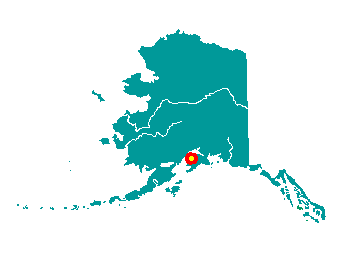|
Kenai
Kenai is located on the western coast of
the Kenai Peninsula, fronting Cook Inlet. It lies on the western
boundary of the Kenai National Wildlife Refuge, on the Kenai Spur
Highway. It is approximately 65 air miles and 155 highway miles
southwest of Anchorage via the Sterling Highway. It lies at
approximately 60░ 33' N Latitude, 151░ 16' W Longitude (Sec. 05, T005N,
R011W, Seward Meridian). The community is located in the Kenai Recording
District. The area encompasses 29 sq. miles of land and 5 sq. miles of
water.
 Prior
to Russian settlement, Kenai was a Dena'ina Athabascan Indian village.
Russian fur traders first arrived in 1741. At that time, about 1,000
Dena'ina lived in the village of Shk'ituk't, near the River. The traders
called the people "Kenaitze," or "Kenai people." In 1791, a fortified
Russian trading post, Fort St. Nicholas, was constructed for fur and
fish trading. It was the second permanent Russian settlement in Alaska.
In 1849, the Holy Assumption Russian Orthodox Church was established by
Egumen Nicholai. In 1869 the U.S. military established a post for the
Dena'ina Indians in the area, called Fort Kenay, which was abandoned in
1870 after Alaska was purchased by the U.S. Prior
to Russian settlement, Kenai was a Dena'ina Athabascan Indian village.
Russian fur traders first arrived in 1741. At that time, about 1,000
Dena'ina lived in the village of Shk'ituk't, near the River. The traders
called the people "Kenaitze," or "Kenai people." In 1791, a fortified
Russian trading post, Fort St. Nicholas, was constructed for fur and
fish trading. It was the second permanent Russian settlement in Alaska.
In 1849, the Holy Assumption Russian Orthodox Church was established by
Egumen Nicholai. In 1869 the U.S. military established a post for the
Dena'ina Indians in the area, called Fort Kenay, which was abandoned in
1870 after Alaska was purchased by the U.S.
A post office was established in 1899.
Through the 1920s, commercial fishing was the primary activity. In 1940,
homesteading enabled the area to develop. The first dirt road from
Anchorage was constructed in 1951. In 1957, oil was discovered at
Swanson River, 20 miles northeast of Kenai - the first major Alaska oil
strike. In 1965, offshore oil discoveries in Cook Inlet fueled a period
of rapid growth. Kenai has been a growing center for oil exploration,
production and services since that time.
|